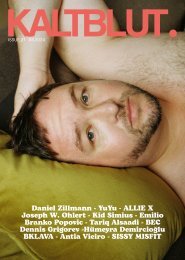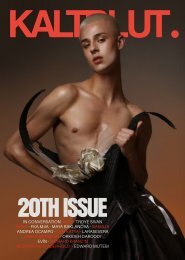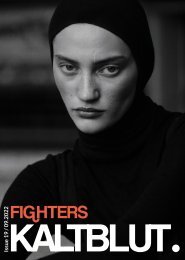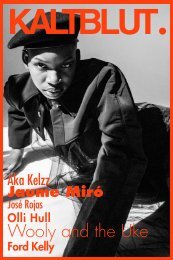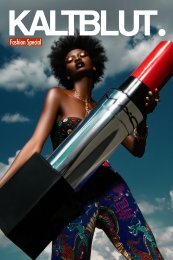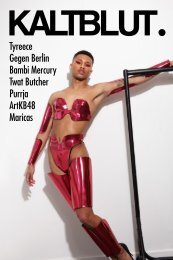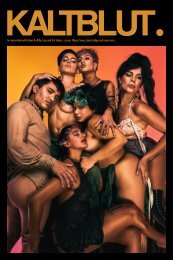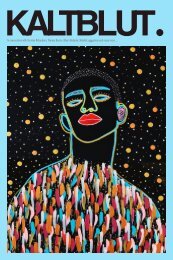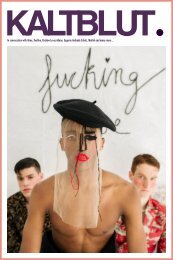COLLECTION 2 - AVANT-GARDE
The Avant-Garde. Hello, welcome to our second KALTBLUT Collection. www.kaltblut-magazine.com 400 pages of the theme Avant-Garde. www.kaltblut-magazine.com Featuring artists like: Adam Green, Tata Christiane, Slava Mogutin, SELLAH, Kristian Jalonen, Kali, Emilie Simon, Tobias Jundt, Remedios Varo, Marc Johns, Reka Koti, Kelly De Block, Berglind Agustsdottir, Andrew Huan, Emma Elina Keira Jones, Amanda Morgan Jansson, Susu Laroche, Jeroen Mylle and many more. Published by Marcel Schlutt
The Avant-Garde. Hello, welcome to our second KALTBLUT Collection. www.kaltblut-magazine.com 400 pages of the theme Avant-Garde. www.kaltblut-magazine.com Featuring artists like: Adam Green, Tata Christiane, Slava Mogutin, SELLAH, Kristian Jalonen, Kali, Emilie Simon, Tobias Jundt, Remedios Varo, Marc Johns, Reka Koti, Kelly De Block, Berglind Agustsdottir, Andrew Huan, Emma Elina Keira Jones, Amanda Morgan Jansson, Susu Laroche, Jeroen Mylle and many more. Published by Marcel Schlutt
Create successful ePaper yourself
Turn your PDF publications into a flip-book with our unique Google optimized e-Paper software.
260 KALTBLUT<br />
KALTBLUT: “The Big Machine” was a rather dramatic record and<br />
contrasted sharply with “Franky Knight” which was sleeker, more<br />
intimate. Is this due to the fact that it was a film score?<br />
Emilie Simon: It’s the context that’s different. “The Big Machine” is<br />
extroverted, influenced by my arrival in New York and its wonderful energy.<br />
“Franky Knight” is an album with more personal, introverted, deep songs,<br />
touching on more human things with a deeper sensitivity. It’s the perfect<br />
backdrop to the film La delicatesse.<br />
KALTBLUT: This is your second film score, right? How do you<br />
approach this type of<br />
composition?<br />
ES: This is my third, in fact. (La marche de l’Empereur by Luc Jacquet and<br />
Survivre avec les loups by Vera Belmont). I love working for the film industry,<br />
and I’m very inspired by images and the relation with film directors. When I fall<br />
in love with a project, I’m happy to put all my skills to work for the film and the<br />
directors.<br />
KALTBLUT: It’s easy to establish a link between the film and your<br />
personal history. Was writing these pieces a necessary step for you?<br />
ES: I needed to write these songs. This album is a gift, an homage.<br />
KALTBLUT: Had these songs already been written or were they specially<br />
composed after David and Stéphane Foenkino’s<br />
proposition?<br />
ES: Some themes were already written before viewing the film and some entirely<br />
created only after viewing.<br />
KALTBLUT: The electronica in your previous albums is almost absent in<br />
this one. Why have you chosen a more instrumental, organic<br />
production?<br />
ES: “Franky Knight” is a human album, quite humble and simple in its<br />
language, and I wanted to emphasize the textures of the natural instruments<br />
being used. The few touches of<br />
electro are subtle.<br />
KALTBLUT: Your music follows a pop format but remains distinct from<br />
today’s production styles. What types of music, bands and styles<br />
influence you today?<br />
ES: My influences aren’t only music, but also movies, painting… the visual arts<br />
in general. It’s very difficult to name one particular band. It’s a number of things<br />
together that influence me every day, and every day is different!<br />
KALTBLUT: You live in New York now. Did that have an effect on the way<br />
you write music or on your artistic practice?<br />
ES: New York has been a great influence on how I write. Writing “The Big<br />
Machine” was very different from the other albums. New York has opened my<br />
mind, and I discovered new things. The city is very welcoming to artists. I live<br />
between New York and Paris.<br />
KALTBLUT: So… bagel or<br />
croissant?<br />
ES: (Laughs) I want croissants in New York and bagels in Paris!<br />
KALTBLUT: As an independent artist, composer and performer, what<br />
are the different steps in creating an album? Is there a set way of doing<br />
things are is it different every time?<br />
ES: Each project has its own concept and its own axes, priorities, sources of<br />
inspiration and fate. For each of my albums, the common principle to each is<br />
the writing, the production, the recording and mixing. But depending on the<br />
album’s concept, I will spend more time in production if there are more<br />
electronic elements, or in the recording studio if the album is more organic and<br />
needs more instrumentals. However, I spend a great amount of time on the<br />
writing for each album.




